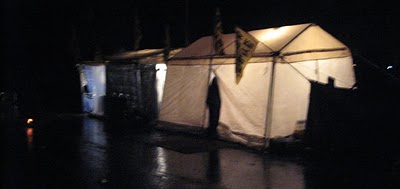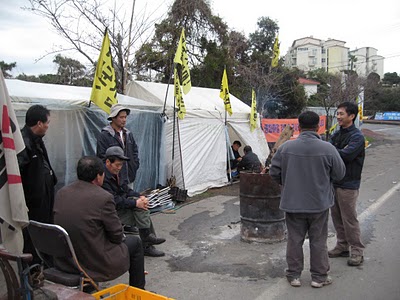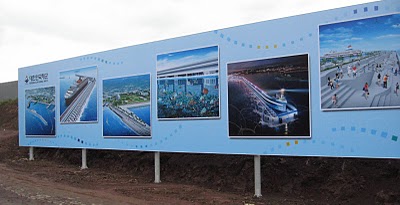For more photos, please see here:
http://nobasestorieskorea.blogspot.com/2010/03/gangjeong-is-strong-and.html
http://space4peace.blogspot.com/2010/03/jeju-island-farmers-continue-to-resist.html
Monday, March 08, 2010
JEJU ISLAND FARMERS CONTINUE TO RESIST NAVY BASE

It has been raining on and off for more than a month in the Gangjeong village. Still the lights in the tents have never been put out in the nights. About 4-5 people in shifts make vigil every day and night. The tents are just off from the site for the planned ceremony for the naval base construction.

Flags cover the tent site. “We death-defiantly oppose the naval base!”

The Navy set up the board depicting how the naval base would be fantastic site for tourists with all the luxurious cruises, flowers and photo-taking tourists. “It’s just nonsensical. If the military base is set-up, who can freely take the pictures of the base? The Navy is insisting the logic that persuades nobody,” villagers say.
By Sung-Hee Choi
Inchon, South Korea
Why it was important to visit the village and hear the villagers’ voice itself? – “Navy’s media manipulation’ should be watched,” the villagers say.
It has constantly been raining in the Gangjeong village for more than a month, except for the few hours off, each day. When I went to the village in the late night of March 5, it was such a raining night, too. Since the police raid on Jan. 18, the villagers have set up the tents and have been doing the tent vigils just near the site of the planned ceremony for the naval base.
A few South Korean newspapers have written that the tension had been high since Jan. 18. According to some articles, it was Feb. 24 that the joint chief of the Navy visited the current governor and Gangjeong village. According to another article, on the very same day, Kim Tae-Young, the Minister of the National Defense Department was announcing in Seoul that the Department wanted to have the ceremony for the naval base construction in March.
Furthermore, an article said that “according to the Navy, the land compensation for the planned area has been done by 51% while compensation for the fishing industry has been done by 80%.”
I had to see myself what were really going on in Gangjeong and listen to the villagers who will now sit in the middle of a dangerous chess game as the U.S. makes a move to checkmate Russia and China in the region, by the naval base plan that the villagers have opposed for more than three years.
Have the villagers given up the struggle? To say conclusion first, the answer was clearly ‘no’. The villagers have never given up their struggle. Their will has seldom been changed. Furthermore, I found during this visit, that they have the confidence in their struggle to win.
It should be all Koreans’ concern that the planned Jeju naval base issue is not only the Island matter but also the matter that tests all South Koreans’ awareness and morality against the U.S. domination strategy to make the North East Asia as dangerous war base against China and Russia, for the interest of a few arms sales corporations.
What the villagers want is their voice to be heard despite Navy’s manipulation of the public opinion.
Even though the tent was not so cold inside as imagined, one can easily imagine all the inconvenience the villagers have had to endure and the desperate spirit that they are going through.
About 4-5 five men sleep in that inconvenient tent every night. They simply call it “Watchful situation” before the highest conflict with the Navy is foreseen in coming soon.
But to my interpretation of the news articles on the Navy plan and progress of land and fishing compensation, the villagers’ response was in a word – ‘a laugh’.
“The Navy and Defense Department are trying to make the naval base construction as if it is an established fact. They are manipulating the public opinion and most media is uncritically supporting them repeating only their words with half-truth. We need the press that really reflects our voice.”
A villager, Mr. Kim who was proud of 400 years history of the village naturally formed and was among the 23 villagers who started the struggle three years ago emphasized that.
“The Navy is simply attempting to enforce the construction, ignoring all the rational and persuasive procedures. They know they cannot but lose in the lawsuits that we have appealed. Regarding the lawsuits, it is almost likely we win. The Navy can hardly repel that. You know what? The lawyers of the Navy showed that they wanted to delay the trial because they, themselves know that they cannot win the trial. That is why they are anxious and trying to manipulate through the press as if all the preparations for the naval base construction are going well.”
“Why the Navy and police raided us in the dawn when there was little press on January 18? They did that because they did not want our voice to be heard.”
“They say it is a civilian-military complex beauty harbor for tourism. The Navy says that if the base is constructed in the Jeju, it would help the villagers with economic benefit of $5,000 each whenever a cruises come in the harbor. But I remember when Kang Chang-Soo, the high Navy officer was saying about the naval base plan years ago, he was not mentioning about cruise AT ALL. Further, the soil of Gangjeong is the best all over the Jeju Island. Gangjeong, as its name, Gang (means river) and Jeong (means water) implies, it is the blessed watery land. You will get water anywhere in Gangjeong. You can never find such land around this area. In the 1960-70s, Gangjeong was famous for the rich rice harvest until the crops were replaced mostly to tangerine. The area where the Navy wants to come in with the base has been once the rice fields that have once fed all the Island people. Whatever crops you raise here, whether it is, rice, garlic or tangerine, you would get the best harvest. Then why we have to give up this best farming land for the sake of naval base whose economic benefit is already clear to be treacherous.”
(His account of why the villagers cannot but oppose the naval base, in light of economic point of view, remind me the Pyeongtaek where the best rice fields in South Korea were forcefully taken away for the base expansion of the U.S. Forces in Korea in 2007, despite people’s strong opposition against it.)
“Look, even though the Navy says about 50 % of the land was compensated, it is exaggeration and lie. You should know why I emphasize the fact that the Gangjeong is the naturally formed village for 400 hundred years. Did you see any apartments in Gangjeong? No, unlike most villages, there is no apartment here. That is one aspect of what the naturally formed village is about. By rule, you cannot sell the land more than 5% inside the naturally formed land. You should know that the Navy bought most of it from the outsiders of the Gangjeong village, who had owned the lands in the village.”
He also said that even though the Navy says in the media that 80% of fishing industry has been compensated, as he knows, no compensation has practically been done. Each of the sea diving women have not gotten money yet because of the complicated distributing issue.
In conclusion, most Gangjeong villagers who have opposed the base from the beginning with the 680 opposition ballots among 700 participants in the general village meeting on August 10, 2007, have still remained true to their original faith and the Navy has not been able to either show the responsible plan nor succeed to get peoples’ hearts.
What makes people angry is the institutional violence under the name of “national policies” that says the nation cannot consider villagers’ opinion such as the vote mentioned above because it is the ‘national policy’.
Yes. Their opinions are not only totally ignored but manipulated as opposite. That is what makes the villagers mad about it and here is the point that the people should really pay attention to.
How the Villagers see the prospect of the Struggle.
The mayor (Kang dong Kyun) whom I met on March 6 was confident that the villagers would have the high possibility to win all the lawsuits that they have appealed including the administrative lawsuit, last April 2009, in which they appealed against the Minister of the National Defense Department for the cancellation of the approval on the national defense/ military facility business realization plan. The procedures that the Navy claims to have gotten through and approved have been done in reality in the illegal and snatched way, totally nonsensical, supported by state power that totally ignore people’s opinion. The Navy knows it themselves and knows that it will lose in the lawsuits, the villagers say.
And the Island governing election is coming on June 2. The Jeju media is covered with all the election issues and the candidates in the opposition parties who know that the naval base issue would be the hot potato have been even saying that they would review all the plans on the naval base from the beginning despite the fact that one of them was mentioning simply to change the site of the base to Hwasoon that was the original candidate site but withdrawn because of people’s fierce struggle for five years there (another betrayal then!).
However, if the Navy still enforces the plan of the base in Gangjeong, then the villagers cannot but fight, at the risk of physical conflict, the mayor said in grave voice.
The mayor was foreseeing the Navy may want to have the ceremony around mid-April, not necessarily related to the lawsuit trial dates and results.
“What we can expect is if the construction begins, the Navy would want to avoid all the conflicts. They would make the police be in front of the struggle, instead of itself. Then, the right-wing thugs in the area will be employed, too, making the situation easily imaginable of dangerous violence against the villagers.”
Yes. It would be the frightening situation, then. The small village of about 600 households with 2,000 residents might turn into the tragically dangerous site. It was one of the reasons that the villagers could not lose their tension. And it may be one of the reasons why more people need to go to Gangjeong, to find the ways to support them.
One of the things I found in the village situation was that more cultural activists are needed in Gangjeong. Currently a movie critic has lived in the tent for more than six months in the cold and windy Joongduk coast. And there are two cartoonists who have done most of the cultural activities, there. But the village needs more artists to go there, to record, and to make their cultural activism to support the tent vigil and other activities.
The Gangjeong village people have fought hard. As a villager said, if the Navy base is set up, all the Jeju Island will be the military base, far different from the Island of Peace.
The South Korea and U.S. are making one of the biggest annual war exercises against North Korea, all over the area of South Korea. They are called “Key Resolve” from March 8-18 and the “Foal Eagle” from March 3 to April 30.
These military war games go against the current of negotiating the Peace Treaty in which the talks on the non-nuclearization of the Korean peninsula should be done at the same time. The US-SK alliance, and US-SK-Japan war alliance, whose first three party military exercise would be done this April, seems to be anxious to anchor in the Jeju Island with this naval base construction plan.
As a villager said, there is no need to set up the base in Jeju if it is against the North Korea. South Korea has already many naval base in Busan, Jinhae, etc.
The base is really against China and will be surely used by the United States, the villagers clearly say. It would be then my and our responsibility to share the struggle with the villagers against the naval base so that the Jeju Island remains as the true Island of Peace, not as the island of war base.





